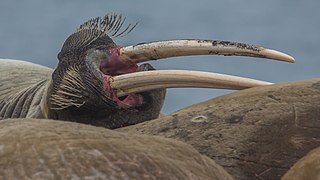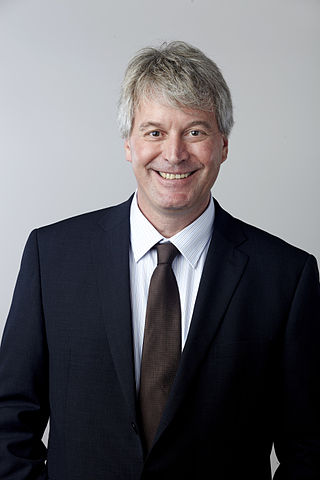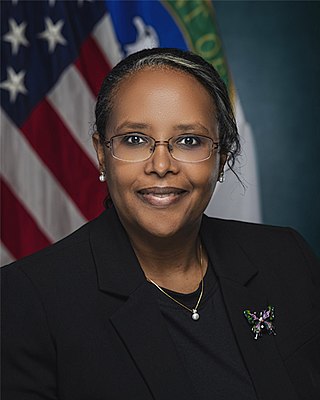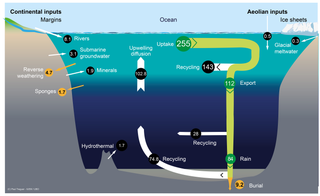
The carbon cycle is the biogeochemical cycle by which carbon is exchanged among the biosphere,pedosphere,geosphere,hydrosphere,and atmosphere of Earth. Carbon is the main component of biological compounds as well as a major component of many minerals such as limestone. Along with the nitrogen cycle and the water cycle,the carbon cycle comprises a sequence of events that are key to make Earth capable of sustaining life. It describes the movement of carbon as it is recycled and reused throughout the biosphere,as well as long-term processes of carbon sequestration to and release from carbon sinks. Carbon sinks in the land and the ocean each currently take up about one-quarter of anthropogenic carbon emissions each year.

A biogeochemical cycle,or more generally a cycle of matter,is the movement and transformation of chemical elements and compounds between living organisms,the atmosphere,and the Earth's crust. Major biogeochemical cycles include the carbon cycle,the nitrogen cycle and the water cycle. In each cycle,the chemical element or molecule is transformed and cycled by living organisms and through various geological forms and reservoirs,including the atmosphere,the soil and the oceans. It can be thought of as the pathway by which a chemical substance cycles the biotic compartment and the abiotic compartments of Earth. The biotic compartment is the biosphere and the abiotic compartments are the atmosphere,lithosphere and hydrosphere.

Biogeochemistry is the scientific discipline that involves the study of the chemical,physical,geological,and biological processes and reactions that govern the composition of the natural environment. In particular,biogeochemistry is the study of biogeochemical cycles,the cycles of chemical elements such as carbon and nitrogen,and their interactions with and incorporation into living things transported through earth scale biological systems in space and time. The field focuses on chemical cycles which are either driven by or influence biological activity. Particular emphasis is placed on the study of carbon,nitrogen,sulfur,iron,and phosphorus cycles. Biogeochemistry is a systems science closely related to systems ecology.

Microbial ecology is the ecology of microorganisms:their relationship with one another and with their environment. It concerns the three major domains of life—Eukaryota,Archaea,and Bacteria—as well as viruses.

Bioturbation is defined as the reworking of soils and sediments by animals or plants. It includes burrowing,ingestion,and defecation of sediment grains. Bioturbating activities have a profound effect on the environment and are thought to be a primary driver of biodiversity. The formal study of bioturbation began in the 1800s by Charles Darwin experimenting in his garden. The disruption of aquatic sediments and terrestrial soils through bioturbating activities provides significant ecosystem services. These include the alteration of nutrients in aquatic sediment and overlying water,shelter to other species in the form of burrows in terrestrial and water ecosystems,and soil production on land.

Dissolved organic carbon (DOC) is the fraction of organic carbon operationally defined as that which can pass through a filter with a pore size typically between 0.22 and 0.7 micrometers. The fraction remaining on the filter is called particulate organic carbon (POC).

Biochar is the lightweight black residue,made of carbon and ashes,remaining after the pyrolysis of biomass. Biochar is defined by the International Biochar Initiative as "the solid material obtained from the thermochemical conversion of biomass in an oxygen-limited environment". Biochar is a stable solid that is rich in pyrogenic carbon and can endure in soil for thousands of years.

The phosphorus cycle is the biogeochemical cycle that describes the movement of phosphorus through the lithosphere,hydrosphere,and biosphere. Unlike many other biogeochemical cycles,the atmosphere does not play a significant role in the movement of phosphorus,because phosphorus and phosphorus-based compounds are usually solids at the typical ranges of temperature and pressure found on Earth. The production of phosphine gas occurs in only specialized,local conditions. Therefore,the phosphorus cycle should be viewed from whole Earth system and then specifically focused on the cycle in terrestrial and aquatic systems.

Soil carbon is the solid carbon stored in global soils. This includes both soil organic matter and inorganic carbon as carbonate minerals. It is vital to the soil capacity in our ecosystem. Soil carbon is a carbon sink in regard to the global carbon cycle,playing a role in biogeochemistry,climate change mitigation,and constructing global climate models. Natural variation such as organisms and time has affected the management of carbon in the soils. The major influence has been that of human activities which has caused a massive loss of soil organic carbon. An example of human activity includes fire which destroys the top layer of the soil and the soil therefore get exposed to excessive oxidation.

Timothy Ian Eglinton is a professor of biogeoscience at the Geological Institute,ETH Zürich.
Mary Ann Moran is a distinguished research professor of marine sciences at the University of Georgia in Athens. She studies the role of bacteria in Earth's marine nutrient cycles,and is a leader in the fields of marine sciences and biogeochemistry. Her work is focused on how microbes interact with dissolved organic matter and the impact of microbial diversity on the global carbon and sulfur cycles. By defining the roles of diverse bacteria in the carbon and sulfur cycles,she connects the biogeochemical and organismal approaches in marine science.

Marine biogeochemical cycles are biogeochemical cycles that occur within marine environments,that is,in the saltwater of seas or oceans or the brackish water of coastal estuaries. These biogeochemical cycles are the pathways chemical substances and elements move through within the marine environment. In addition,substances and elements can be imported into or exported from the marine environment. These imports and exports can occur as exchanges with the atmosphere above,the ocean floor below,or as runoff from the land.
Ann Pearson is the Murray and Martha Ross Professor of Environmental Sciences at Harvard University and current chair of the Department of Earth and Planetary Sciences. Her research in the area of organic geochemistry is focused on applications of analytical chemistry,isotope geochemistry,and molecular biology to biochemical oceanography and Earth history.

Asmeret Asefaw Berhe is a soil biogeochemist and political ecologist who is the current Director of the Office of Science at the US Department of Energy. She was previously the Professor of Soil Biogeochemistry and the Ted and Jan Falasco Chair in Earth Sciences and Geology in the Department of Life and Environmental Sciences;University of California,Merced. Her research group worked to understand how soil helps regulate the earth's climate.

The silica cycle is the biogeochemical cycle in which biogenic silica is transported between the Earth's systems. Silicon is considered a bioessential element and is one of the most abundant elements on Earth. The silica cycle has significant overlap with the carbon cycle and plays an important role in the sequestration of carbon through continental weathering,biogenic export and burial as oozes on geologic timescales.
Wendy Yang is an associate professor of Plant Biology and Geology at the University of Illinois Urbana-Champaign where she works on soil biogeochemistry and ecosystem ecology.
M. Francesca Cotrufo is a soil ecologist who focuses her work on litter decomposition and the dynamics of soil organic matter. She is currently a Professor and Associate Head in the Department of Soil and Crop Sciences,as well the Senior Scientist at the Natural Resource Ecology Lab,at Colorado State University.

The gold cycle is the biogeochemical cycling of gold through the lithosphere,hydrosphere,atmosphere,and biosphere. Gold is a noble transition metal that is highly mobile in the environment and subject to biogeochemical cycling,driven largely by microorganisms. Gold undergoes processes of solubilization,stabilization,bioreduction,biomineralization,aggregation,and ligand utilization throughout its cycle. These processes are influenced by various microbial populations and cycling of other elements such as carbon,nitrogen,and sulfur. Gold exists in several forms in the Earth's surface environment including Au(I/III)-complexes,nanoparticles,and placer gold particles. The gold biogeochemical cycle is highly complex and strongly intertwined with cycling of other metals including silver,copper,iron,manganese,arsenic,and mercury. Gold is important in the biotech field for applications such as mineral exploration,processing and remediation,development of biosensors and drug delivery systems,industrial catalysts,and for recovery of gold from electronic waste.
Clare Reimers is a Distinguished Professor of Ocean Ecology and Biogeochemistry at Oregon State University's College of Earth,Ocean and Atmospheric Sciences.
Elizabeth A. Canuel is a chemical oceanographer known for her work on organic carbon cycling in aquatic environments. She is the Chancellor Professor of Marine Science at the College of William &Mary and is an elected fellow of the Geochemical Society and the European Association of Geochemistry.












